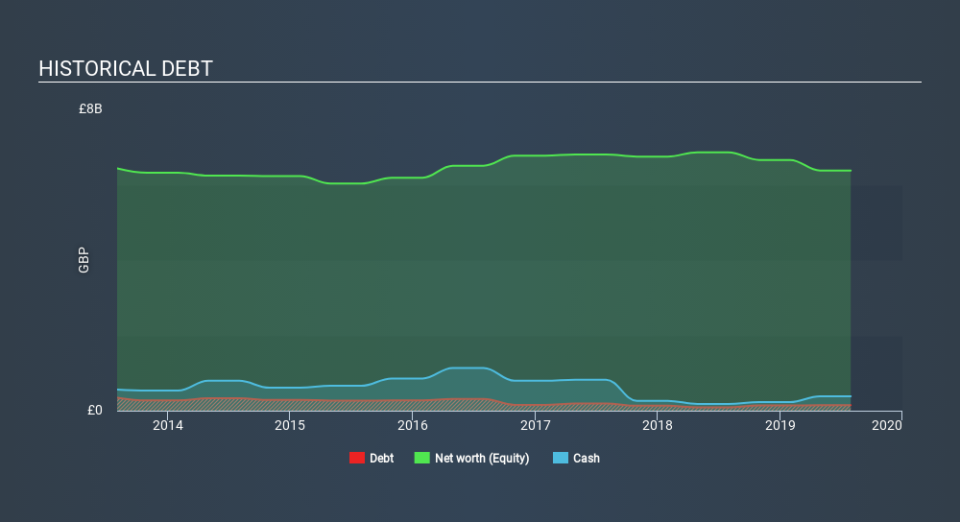Is Kingfisher (LON:KGF) A Risky Investment?

David Iben put it well when he said, 'Volatility is not a risk we care about. What we care about is avoiding the permanent loss of capital. When we think about how risky a company is, we always like to look at its use of debt, since debt overload can lead to ruin. We can see that Kingfisher plc (LON:KGF) does use debt in its business. But the more important question is: how much risk is that debt creating?
When Is Debt A Problem?
Debt is a tool to help businesses grow, but if a business is incapable of paying off its lenders, then it exists at their mercy. If things get really bad, the lenders can take control of the business. However, a more usual (but still expensive) situation is where a company must dilute shareholders at a cheap share price simply to get debt under control. Of course, the upside of debt is that it often represents cheap capital, especially when it replaces dilution in a company with the ability to reinvest at high rates of return. The first step when considering a company's debt levels is to consider its cash and debt together.
Check out our latest analysis for Kingfisher
How Much Debt Does Kingfisher Carry?
The image below, which you can click on for greater detail, shows that at July 2019 Kingfisher had debt of UK£144.0m, up from UK£89.0m in one year. But it also has UK£385.0m in cash to offset that, meaning it has UK£241.0m net cash.
How Healthy Is Kingfisher's Balance Sheet?
According to the last reported balance sheet, Kingfisher had liabilities of UK£3.17b due within 12 months, and liabilities of UK£2.83b due beyond 12 months. Offsetting this, it had UK£385.0m in cash and UK£418.0m in receivables that were due within 12 months. So its liabilities total UK£5.20b more than the combination of its cash and short-term receivables.
When you consider that this deficiency exceeds the company's UK£3.74b market capitalization, you might well be inclined to review the balance sheet intently. Hypothetically, extremely heavy dilution would be required if the company were forced to pay down its liabilities by raising capital at the current share price. Given that Kingfisher has more cash than debt, we're pretty confident it can handle its debt, despite the fact that it has a lot of liabilities in total.
On the other hand, Kingfisher's EBIT dived 16%, over the last year. We think hat kind of performance, if repeated frequently, could well lead to difficulties for the stock. The balance sheet is clearly the area to focus on when you are analysing debt. But ultimately the future profitability of the business will decide if Kingfisher can strengthen its balance sheet over time. So if you want to see what the professionals think, you might find this free report on analyst profit forecasts to be interesting.
Finally, a business needs free cash flow to pay off debt; accounting profits just don't cut it. Kingfisher may have net cash on the balance sheet, but it is still interesting to look at how well the business converts its earnings before interest and tax (EBIT) to free cash flow, because that will influence both its need for, and its capacity to manage debt. In the last three years, Kingfisher created free cash flow amounting to 14% of its EBIT, an uninspiring performance. That limp level of cash conversion undermines its ability to manage and pay down debt.
Summing up
While Kingfisher does have more liabilities than liquid assets, it also has net cash of UK£241.0m. Despite the cash, we do find Kingfisher's level of total liabilities concerning, so we're not particularly comfortable with the stock. There's no doubt that we learn most about debt from the balance sheet. But ultimately, every company can contain risks that exist outside of the balance sheet. To that end, you should be aware of the 3 warning signs we've spotted with Kingfisher .
When all is said and done, sometimes its easier to focus on companies that don't even need debt. Readers can access a list of growth stocks with zero net debt 100% free, right now.
If you spot an error that warrants correction, please contact the editor at editorial-team@simplywallst.com. This article by Simply Wall St is general in nature. It does not constitute a recommendation to buy or sell any stock, and does not take account of your objectives, or your financial situation. Simply Wall St has no position in the stocks mentioned.
We aim to bring you long-term focused research analysis driven by fundamental data. Note that our analysis may not factor in the latest price-sensitive company announcements or qualitative material. Thank you for reading.

 Yahoo Finance
Yahoo Finance 
